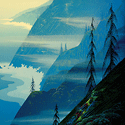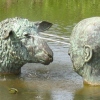|
You can get a Wacom Bamboo for about forty bucks.
|
|
|
|

|
| # ? Apr 28, 2024 07:37 |
|
Stupid newbie question (probably): I work in a cancer research lab, and we've got a big store of digital images of microscope slides containing stained tissue. Some of these slides contain significant deposits of darker pigmentation which can interfere with certain assays. I'd like to set up some image processing method to make this pigmentation identifiable at a glance to laypeople (read: some administrative higher-ups) and easily quantifiable. Basically, would there be a way to set up a filter/something in photoshop (CS4) that can: 1. Take pixels that have a certain range of RGB values, and replace them with pure black pixels (or something equally easy to spot)? 2. Only take pixels within that RGB range which are also in close proximity to other pixels that fall in that range? (pigmentation tends to occur in big blobs) 3. Count how many pixels satisfied those two requirements? Any help is appreciated-sorry if this is a dumb question, I've never worked with photoshop before, my only image processing experience is a little dabbling in gimp and imagej.
|
|
|
|
CarrotFlowers posted:I'm really terrible at photoshop. I figured with practice I'd get better, but I'm still awful at cloning/healing, and I'd really like to get better at it. Just from searching for tutorials, all I can find are really basic ones that show you how to use it in really generic situations. Anyone know of more detailed ones that have some tips/tricks and are more advanced for cloning out a major object with a busy background? I feel like there is a whole world of awesome available to me that I can't quite get at. I bought a wacom but I never use it. I also use the Nik suite for most of my editing. There is no need to use a tablet with it and I find it a superior way to make local adjustments. If I have to do some light cloning (like removing a pimple or a dust spot) I'll just use Aperture. If I have to do some heavy cloning (like say remove a telephone pole) I'll load up CS5 and use content aware fill. Never needed anything more than a mouse/trackpad. Maybe I'm doing something wrong, but I'm not really seeing the advantage of owning a table. I could see where it would be useful for dodging and burning, but I really think it's better to do that in Viviza.
|
|
|
|
Haggins posted:
lol A tablet is insanely powerful for subtle stuff. Dodging and burning slightly can be done with the mouse, but if you want fine control quickly, or to paint in details that don't exist or can't be cloned from, a tablet is indispensable. When a bamboo can be had for 40 bux in a hobby where you can't even enter for much less than 600-1000 bux, there isn't much excuse for not having one. I don't use my wacom on every photo, but I did on every portfolio image of mine. Plus you can do stuff like this with a tablet (mine): https://vimeo.com/27213367
|
|
|
|
poopinmymouth posted:lol I'm definitely not a great photographer or particularly great at post-processing, but I'm enjoying my tablet a whole lot too. I have a bamboo and it was really cheap. I really love the amount of control it gives me for many things. I love it with photoshop mostly when working with masks. It's a lot of fun for dodging and burning too
|
|
|
|
CarrotFlowers posted:Anyone know of more detailed ones that have some tips/tricks and are more advanced for cloning out a major object with a busy background? I feel like there is a whole world of awesome available to me that I can't quite get at. You Suck At Photoshop
|
|
|
|
David Pratt posted:You Suck At Photoshop Awesome, thanks! And regarding the tablet...everyone says there are ones for $40, but I don't know if the prices are just different where I am, but I can't find a Wacom bamboo for less than $100, unless you count the touch pad without the pen, which I don't think would be very useful. I know it's not a lot in comparison to actual photography dollars, but I have to draw the line somewhere, especially considering I don't make a cent off my photography. Like I said, some day I hope to own one, but it's not feasible for me at the moment, and I know there are ways to improve without one.
|
|
|
|
CarrotFlowers posted:Awesome, thanks! ebay! If I remember right you're in Canada - just had a look and you can buy it new for around 75 of your Canadian moon dollars.
|
|
|
|
sentientcarbon posted:Stupid newbie question (probably): Since you're in a research lab, do you not have access to MATLAB? You can do some really powerful stuff with it along these lines.
|
|
|
|
Paragon8 posted:ebay! If I remember right you're in Canada - just had a look and you can buy it new for around 75 of your Canadian moon dollars. Yeah, I should get over my irrational fear of ebay and cough up some moon bucks for one. I searched and I found one that's fairly cheap. Costs less than a new kindle anyway... Thanks!
|
|
|
|
poopinmymouth posted:lol I've tried it but I still feel like I get more control with Viveza. Not to mention, it's a whole helluva lot quicker. As for cloning, I don't do it often and when I do, it's usually so small it doesn't matter what I use.
|
|
|
|
MrBlandAverage posted:Since you're in a research lab, do you not have access to MATLAB? You can do some really powerful stuff with it along these lines. Remarkably no, the closest thing we have is SAS. Although we are part of a university system, so I may be able to find someone to get me an academic license for MATLAB. That'll probably take a while though  . .I had a free half-hour today and worked with it a bit, so far it's looking like my best options are the magic wand tool (bleh) or selecting a color range and setting a low fuzziness level (actually works ok, but I'd much prefer setting well-defined RGB ranges than just upping 'fuzziness' since I'm not quite sure how that's defined). I also poked around online and found a forum where someone had a similar issue, and advanced blending modes/manual masks were suggested, but the tutorial links that were posted were broken. Any of these sound like I'm heading in the right direction?
|
|
|
|
I have a 4x5 Intuos2 and quite frankly it's so small that it often hinders my productivity. It's almost easier to use the mouse than have to worry about whether I'm going to start drawing outside of its ridiculously small sensor area. I mean it's good for some things, but until I get a bigger one it's really relegated to just sketching things. I'd rather do most of my post with a mouse at this point. Which is sad because I had a nice 9x12 that I eBayed before I got into photography and creative stuff in general because "I didn't think I'd ever need one"
|
|
|
|
I use a 4x5 tablet as my "travel" tablet for jobs and have no problems doing very heavy retouching with it. I think the medium sized tablets are the best, 9x12 and up for me is too big for photo retouching. Trying to use a mouse for retouching is like trying to perform surgery with an axe. If you're just removing zits then it's not worth it, but anything more involved than that to me there's no question. There is a very slight learning curve but once you get over it you can do a lot of things that are impossible with a mouse. As for "how do I get better at clone stamp" just practice a LOT.
|
|
|
|
sentientcarbon posted:Stupid newbie question (probably): I assume you've tried NIH Image (aka ImageJ)? There's a lot of packages written for it, and it can certainly do the pixel-counting.
|
|
|
|
Haggins posted:I've tried it but I still feel like I get more control with Viveza. Not to mention, it's a whole helluva lot quicker. As for cloning, I don't do it often and when I do, it's usually so small it doesn't matter what I use. No one is going to tell you your personal workflow is wrong. If you like viveza more and don't think a tablet would help, that's your prerogative. But as this is the post processing "how to" advice thread, the objectively good advice for someone wanting to get better at post is "buy a tablet".
|
|
|
|
CarrotFlowers posted:I'm really terrible at photoshop. I figured with practice I'd get better, but I'm still awful at cloning/healing, and I'd really like to get better at it. Just from searching for tutorials, all I can find are really basic ones that show you how to use it in really generic situations. Anyone know of more detailed ones that have some tips/tricks and are more advanced for cloning out a major object with a busy background? I feel like there is a whole world of awesome available to me that I can't quite get at. This gives me an idea for a video tutorial.
|
|
|
|
With regards to video tutorials I can sort of recommend Gry Garness's stuff. She's a pro retoucher in London. The actual db tutorial she has is a bit disappointing in that it's just a conventional image - I'd have liked to see her explain a full on fashion retouch. DB is very tricky and there are a few really good methods that are all fairly different. Once it clicks it really clicks though. A lot of it is practice and it is hellishly frustrating at first because you don't see quick changes. I've been using a A5 bamboo to retouch and really don't feel like I need anything more. I was a little concerned as I upgraded to a larger screen but it still works great. I have hosed around with viveza and some nik software stuff and I was pretty impressed with some of what it did. I couldn't imagine replacing db as a skin retouch method with viveza. I do like the ability to soften some shadows quite easily though.
|
|
|
|
sentientcarbon posted:Remarkably no, the closest thing we have is SAS. Although we are part of a university system, so I may be able to find someone to get me an academic license for MATLAB. That'll probably take a while though If you're set on using Photoshop, look into Photoshop scripting - start here: http://www.adobe.com/devnet/photoshop/scripting.html But I would really rather use a purpose-built scientific tool for this kind of analysis. BetterLekNextTime's suggestion of ImageJ looks interesting - and it's free.
|
|
|
|
You could probably do it on the cheap with something like ImageMagick. But this assumes you have any kind of scripting capability.
|
|
|
|
MrBlandAverage posted:If you're set on using Photoshop, look into Photoshop scripting - start here: http://www.adobe.com/devnet/photoshop/scripting.html Yeah- I guess I should have been more descriptive there. NIH Image is freeware. It looks (and is) old school, but it seems to work for a lot of kinds of scientific image analysis. I've only used it for a few things, but it seems like a pretty flexible framework. People use it for counting bacterial colonies on plates, edge detection, measuring sizes of things in images with a size standard, etc. It seems good at batch-processing folders full of images, and also storing and exporting measured values. Hopefully you can find the exact plug-in you need- the documentation is not always the easiest. http://rsbweb.nih.gov/nih-image/about.html
|
|
|
|
Wacom Intuos 4 Medium size + Lightroom 3 for $399 ... looks like you'll save about $90. http://www.wacom.com/en/Products/Intuos/LightroomBundle.aspx?elq=%3Cspan I know LR3 goes on sale from time to time, what about Wacom tablets?
|
|
|
|
What's the difference between the Intuos and the Bamboo? The price difference is rather significant.
|
|
|
|
Intuos has 2048 levels of sensitivity and 5080 lines per inch vs Bamboo's 1024/2540 respectively.
|
|
|
|
I'm guessing that for retouching needs the sensitivity levels aren't all that important? I'd think that is more for drawing/painting... unless it works with photoshop differently than I'd expect it to.
|
|
|
|
Sensitivity can be important for cloning and healing and masking if you're using alpha to denote the opacity of your changes. I guess it should be pointed out that even an old Bamboo with 512 levels of sensitivity will be more useful at interactive masking than your mouse will be with its sensitivity level of 1. I probably used all the wrong terms and that last few sentences make no sense, but I can see where sensitivity would be important. I should just shut up and let people who use the tools every day comment 
|
|
|
|
I've used a tablet PC with only 256 levels and didn't notice the difference. Physical size and ensuring it's Wacom brand is the important part.
|
|
|
|
Yeah. a bamboo is more than enough for most retouching. If you need more than a bamboo you can probably afford it of all the dope retouching money you're making
|
|
|
|
I'm still using an Intuos 2 6x8 that I bought in university, 10 years ago.
|
|
|
|
poopinmymouth posted:I'm still using an Intuos 2 6x8 that I bought in university, 10 years ago. It kind of blows my mind how dominant wacom is. Fantastic products especially now that they updated the cintiqs.
|
|
|
|
most of the tutorials here are for photoshop. Where does aperture come into play in respect to workflow?
|
|
|
|
Anti-Derivative posted:most of the tutorials here are for photoshop.
|
|
|
|
Okay magic ps experts. I need to get rid of the dog stuff in the picture below. Hindsight...should have taken them out when I took the picture. I figure this is good practice for me too, but everytime I try, I make a sloppy, really obvious mess. I am using content aware fill, patch, clone stamp and the healing brush, and I am just making a godawful mess. Is there something else I should be using? IMG_0237 by bernsai, on Flickr
|
|
|
|
Paragon8 posted:Yeah. a bamboo is more than enough for most retouching. If you need more than a bamboo you can probably afford it of all the dope retouching money you're making I lost the stylus to my Bamboo (later found it), so I splurged on a barely-used Intuos3 on eBay for $100. I think the stylus is a lot more comfortable (not that the Bamboo is terrible), although I've not noticed any real difference in the sensitivity levels.
|
|
|
|
Have any of you RAW shooters found that Lightroom can be really crappy sometimes? I was working on some photos of a church that I shot, and the dusk shots have some really crazy black blotchy areas in the deep blue sky that should otherwise be fine. Same thing happened on a white part of the image. Before I drove myself batty cloning out all of them, I switched to Capture One Pro 6 and got a flawless image out of the RAW file. I have only recently begun doing all my PP in Lightroom, but the recent annoyances and sub-standard quality I've seen is really pushing me back towards C1. Has anyone else found it to be a bit underwhelming? Sometimes it's great, like for processing shots of friends and the like, but I'm really starting to feel like my older workflow of C1 and PS yielded much higher quality results.
|
|
|
|
CarrotFlowers posted:Okay magic ps experts. I need to get rid of the dog stuff in the picture below. Hindsight...should have taken them out when I took the picture. I figure this is good practice for me too, but everytime I try, I make a sloppy, really obvious mess. I am using content aware fill, patch, clone stamp and the healing brush, and I am just making a godawful mess. Is there something else I should be using? You are going to need some painting skills for this. If it were mine, I'd make a new layer, then using the standard paint brush, and color picking from within the image, I'd "paint out" the stuff, the bowls first, then on another layer the mattress. At this point I would have an image that passes the thumbnail viewing size, but is too painterly, so I'd steal surface texture using clone/heal to make it more realistic. You have too little smooth surfaces, and too much missing objects (the bottom of the table legs) and then perspective and mixed lighting making the tiles almost useless. Like I'd start with "dark tile" color and paint over the mattress, ignoring the grout, just getting the general tone of the floor right. Then I'd paint with browns picked from the table legs for the table legs. If you've never painted anything... good luck! *edit* what the hell, i had a moment. This is with a mouse so it's not that smooth, but this shows how I'd paint it out, this is just a 100% opaque brush with 50% blurry edge to lay down color, then backed off to 40% to smooth the tones on the floor. I have another layer for the table wood, and a third for the tile grout. I could easily go over this now with the heal or clone slowly to bring back in the proper texture. 
poopinmymouth fucked around with this message at 10:31 on Sep 22, 2011 |
|
|
|
I'm just getting into photography and I'm trying to set up a home network so that my wife and I can both view and edit the same library. I'm posting this here because I'm specifically looking for advice on setting up a system to share and edit photos. I'm considering a NAS which would store a lightroom library/catalog and raw files. I've read that Lightroom won't run if the catalog is on a network drive, but if I use a symlink I can supposedly trick it into working. Does anyone have any experience with a setup like this? It doesn't seem that uncommon to want to have a couple of people be able to edit a library catalog, but I'm also not seeing any examples online of good ways to set that up. I haven't bought lightroom yet, so if anyone wants to suggest something else I'm game to check it out. I know I can have the photos on the NAS and our computers could have their own copies of the lightroom catalog, but my requirement is that we can both edit keywords. If we can't work at the same time that's fine. I'm planning to buy a fast, 100MB/s NAS so that the performance will be decent (probably a Synology DS411+ii). Does anyone have experience with lightroom running with photos stored on a network share?
|
|
|
|
poopinmymouth posted:helpful stuff Thanks, pimm! You're the best. I'll give it a go this weekend.
|
|
|
|
You can probably make doing the tile easier by using the Vanishing Point tool.
|
|
|
|

|
| # ? Apr 28, 2024 07:37 |
|
Guitarchitect posted:Have any of you RAW shooters found that Lightroom can be really crappy sometimes?
|
|
|




















